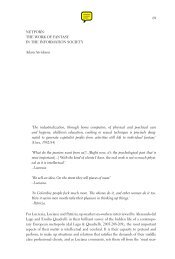Nakamura, Digitizing Race, Introduction, chapter 5, Epilogue
Nakamura, Digitizing Race, Introduction, chapter 5, Epilogue
Nakamura, Digitizing Race, Introduction, chapter 5, Epilogue
Create successful ePaper yourself
Turn your PDF publications into a flip-book with our unique Google optimized e-Paper software.
Avatars and the Visual Culture of Reproduction 155<br />
are pregnant. Web sites that deal with domestic, everyday, or commercial<br />
matters have heretofore been the province of sociologists and graphic designers<br />
or usability experts, such as Edward Tufte, whose Envisioning Information<br />
has become a standard text in information design. This discourse of transparency<br />
and usability values efficiency and density of information and does<br />
not discuss new media objects in terms of visual culture. “Look and feel” are<br />
elements of button positioning, font size, use of white space, and intuitive<br />
icons and are not used to signify anything vis-à-vis what sorts of offline<br />
visual traditions are being referenced.<br />
Parenting Web sites exemplify the ways that women use the Internet to<br />
graphically embody themselves in specific reproductive states, that is, as pregnant<br />
women, nursing women, and mothers. They draw significant numbers<br />
of women who exemplify the profile of the “late adopter” of the Internet;<br />
that is to say, they are often stay-at-home mothers from the working or<br />
middle classes rather than professionals who might be required to use the<br />
Internet for work. They are more likely than in previous years to be members<br />
of racial minority groups who have previously been represented very poorly<br />
online, such as African American and Latino. In addition, they defy their<br />
gender profile in relation to the Internet because they are deeply involved<br />
in digital production: they upload significant amounts of online content in<br />
the form of their large and detailed postings and digital signatures.<br />
Pregnant avatars challenge many conventional ideas regarding online<br />
embodiment. While nobody believes anymore that on the Internet nobody<br />
knows you’re a dog, it is certainly true that many women offline can exist<br />
for several months without anybody knowing that they are pregnant. Women<br />
who work outside the home must carefully weigh factors such as economic<br />
need and work climate when they decide how and when they wish to reveal<br />
their pregnancies in the workplace. This discourse of “outing” is in some<br />
sense a queer one; pregnancy is a state of difference whose visibility and legibility<br />
are, at least at first, performative and volitional. Thus pregnant avatars<br />
represent a state that is by definition temporary. They signify a changing<br />
body, in some sense an ephemeral body. In addition, an avatar can be pregnant<br />
in the “public” space of the Internet bulletin board, while its owner<br />
may be still closeted in public. The pregnant avatar memorializes a body in<br />
transition, one that is out of the user’s control. The Internet is likewise a<br />
space of ephemerality, as its content changes rapidly and constantly. In addition,<br />
pregnant avatars have a certain literal quality that leads to intriguing<br />
phenomenological questions: Would a user keep a pregnant avatar if she





